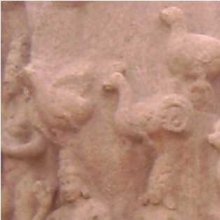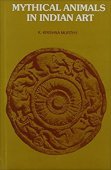Cock: 3 definitions
Introduction:
Cock means something in Buddhism, Pali, Hinduism, Sanskrit, the history of ancient India. If you want to know the exact meaning, history, etymology or English translation of this term then check out the descriptions on this page. Add your comment or reference to a book if you want to contribute to this summary article.
Images (photo gallery)
In Hinduism
Shilpashastra (iconography)
Source: Shodhganga: Elements of Art and Architecture in the Trtiyakhanda of the Visnudharmottarapurana (shilpa)Cocks (in crying mood) are associated with the time of Dawn, and follows specific guidelines of ancient Indian Painting (citra), according to the Viṣṇudharmottarapurāṇa, an ancient Sanskrit text which (being encyclopedic in nature) deals with a variety of cultural topics such as arts, architecture, music, grammar and astronomy.—In the Viṣṇudharmottarapurāṇa, the rules of Painting of different classes have been elaborately discussed. The time of uṣā i.e., dawn when the sun is about to rise. It seems to be a beautiful source of Painting. The picture of this time is associated with the rising of the sun, dim lamps and cocks in crying mood. [...]. Thus the Viṣṇudharmottarapurāṇa establishes the fact that even in the pictures; the people belonging to different class and profession [e.g., cocks in crying mood] were projected with specific attire so that general people can equate the picture with the practical character.

Shilpashastra (शिल्पशास्त्र, śilpaśāstra) represents the ancient Indian science (shastra) of creative arts (shilpa) such as sculpture, iconography and painting. Closely related to Vastushastra (architecture), they often share the same literature.
In Buddhism
Tibetan Buddhism (Vajrayana or tantric Buddhism)
Source: academia.edu: The Structure and Meanings of the Heruka MaṇḍalaThe Cock (animal) is associated with the Yoginī (female deity) named Tāmracūḍī, being situated in the Vāyucakra, according to the 10th century Ḍākārṇava-tantra: one of the last Tibetan Tantric scriptures belonging to the Buddhist Saṃvara tradition consisting of 51 chapters.—Accordingly, the vāyucakra refers to one of the three divisions of the dharma-puṭa (‘dharma layer’), situated in the Herukamaṇḍala. The 36 pairs of Ḍākinīs [viz., Tāmracūḍī—“Cock”] and Vīras are dark blue in color; they each have one face and four arms; they hold a skull bowl, a skull staff, a small drum, and a knife.

Tibetan Buddhism includes schools such as Nyingma, Kadampa, Kagyu and Gelug. Their primary canon of literature is divided in two broad categories: The Kangyur, which consists of Buddha’s words, and the Tengyur, which includes commentaries from various sources. Esotericism and tantra techniques (vajrayāna) are collected indepently.
India history and geography
Source: Singhi Jain Series: Ratnaprabha-suri’s Kuvalayamala-katha (history)Cocks were commonly depicted on the Saṃsāracakra paintings (representing scenes of human life), in ancient India, as mentioned in the Kathās (narrative poems) such as Uddyotanasūri in his 8th-century Kuvalayamālā (a Prakrit Campū, similar to Kāvya poetry).—Page 185.21 f.: Here follows a description of a printed scroll illustrating the Jaina conception of saṃsāracakra. [...] The saṃsāra-cakra illustrated the three worlds of hell, human world and the world of gods. [For example:] A young boy amusing himself with the fight of cocks, male parrots, rams; a young man enjoying the company of young girls and maidens.

The history of India traces the identification of countries, villages, towns and other regions of India, as well as mythology, zoology, royal dynasties, rulers, tribes, local festivities and traditions and regional languages. Ancient India enjoyed religious freedom and encourages the path of Dharma, a concept common to Buddhism, Hinduism, and Jainism.
See also (Relevant definitions)
Starts with (+3): Cock blood, Cock-fight, Cock-foot panicum, Cockatoo grass, Cockey apple, Cockle, Cockle bur, Cockle-button, Cocklebur, Cockroach, Cockroach berry, Cockroach grass, Cockroach plant, Cockshun, Cockspur, Cockspur coral bean, Cockspur coral tree, Cockspur grass, Cockspur panic grass, Cockspur thistle.
Query error!
Full-text (+497): Kukkuta, Krikavaku, Tamracuda, Gramakukkuta, Kukkubha, Vrikshakukkuta, Pranidyuta, Caranayudha, Kukuku, Svarnacuda, Kukadeku, Shikhandika, Pucchin, Kuhakasvana, Mayuracataka, Niyoddhri, Atmaghosha, Rasakhana, Ushakala, Kahala.
Relevant text
Search found 162 books and stories containing Cock, The cock; (plurals include: Cocks, The cocks). You can also click to the full overview containing English textual excerpts. Below are direct links for the most relevant articles:
Manasollasa (study of Arts and Sciences) (by Mahadev Narayanrao Joshi)
9. Cock fighting described in the Manasollasa < [Chapter 3 - Social and Political conditions reflected in Somesvara’s Manasollasa]
1. Introduction: the Manasollasa and Encyclopaedic knowledge < [Chapter 6 - Manasollasa: the first Encyclopaedia]
Trishashti Shalaka Purusha Caritra (by Helen M. Johnson)
Part 8: Story of origin of animal sacrifices < [Chapter II - Rāvaṇa’s expedition of Conquest]
Part 2: Story of the cocks < [Chapter IV - Tenth incarnation as Megharatha]
Part 3: Former births of the cocks < [Chapter IV - Tenth incarnation as Megharatha]
The Cock < [January – March, 1986]
Agony of Flower < [July – September 1991]
Two Poems of Sangam Tamil < [July – September, 1979]
Skanda Purana (by G. V. Tagare)
Chapter 21 - Kukkuṭeśvara (kukkuṭa-īśvara-liṅga) < [Section 2 - Caturaśīti-liṅga-māhātmya]
Chapter 98 - Departure unto the Pavilion of Salvation < [Section 2 - Uttarārdha]
Chapter 20 - The Great Efficacy of Rudrākṣa: The Story of Mahānandā < [Section 3 - Brāhmottara-khaṇḍa]
Jataka tales [English], Volume 1-6 (by Robert Chalmers)
Jataka 383: Kukkuṭa-jātaka < [Volume 3]
Jataka 445: Nigrodha-jātaka < [Volume 4]
Jataka 119: Akālarāvi-jātaka < [Book I - Ekanipāta]
Village Folk-tales of Ceylon (Sri Lanka), vol. 1-3 (by Henry Parker)
Story 266 - The Teacher and his Pupil < [Part III (c) - South Indian Stories]
Story 169 - The Gamarala And The Cock < [Part III - Stories of the Cultivating Caste]
Story 199 - The Wicked Step-mother < [Part III (a) - Stories of the Lower Castes]
Related products

